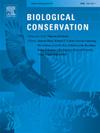Testing the soundscape response to silvicultural interventions in a controlled before-and-after experiment
IF 4.4
1区 环境科学与生态学
Q1 BIODIVERSITY CONSERVATION
引用次数: 0
Abstract
In forest ecosystems, soundscape recordings are increasingly used to measure loss or shifts in biodiversity. In particular, acoustic indices can quantify the response of biodiversity to human interventions. However, most soundscape studies only use observational data, which precludes causal conclusions. To improve the use of acoustic indices as tools for conservation, experimental validation is essential. In a before-after experiment, we manipulated the canopy structural complexity of 59 broadleaf forest patches (50 m × 50 m) in Germany through silvicultural interventions, recorded their before-after soundscapes and calculated four well-established acoustic indices. The manipulation entailed a variation in logging intensity (0–33.3 % of basal area), different spatial arrangements (aggregated as gaps vs. distributed as thinnings), and the creation of standing deadwood. Linear mixed models controlling for pre-treatment levels showed increasing Soundscape Saturation and Acoustic Complexity with logging intensity particularly during the day, probably as a response of increased bird vocalization. During the night, these indices were lower in gaps, probably as a response of lower canopy insect activity in the absence of trees. We found more Events per Second, a measure of acoustic activity, in open canopy forests. None of the small-scale interventions altered the before-after synchrony of the circadian soundscape pattern, indicating no drastic shifts in the vocalizing community. Our results demonstrate that enhancing forest complexity by interventions can increase soundscape diversity in commercial forests and highlight the importance of recording the whole diurnal cycle for comprehensive insights into temperate forest soundscapes.
在对照前后试验中测试声景观对造林干预的反应
在森林生态系统中,声景记录越来越多地用于测量生物多样性的损失或变化。特别是,声学指标可以量化生物多样性对人类干预的响应。然而,大多数声景研究仅使用观测数据,这排除了因果结论。为了改进声学指标作为保护工具的使用,实验验证是必不可少的。通过对德国59个阔叶林斑块(50 m × 50 m)的造林干预,对其冠层结构复杂性进行了控制,记录了其前后声景观,并计算了4个已建立的声指数。这种操纵导致了伐木强度的变化(0 - 33.3%的基底面积),不同的空间安排(聚集为间隙或分布为疏林),以及直立枯木的产生。控制预处理水平的线性混合模型显示,声景饱和度和声学复杂性随着测井强度的增加而增加,尤其是在白天,这可能是鸟类发声增加的反应。在夜间,这些指数在林隙中较低,这可能是在没有树木的情况下,冠层昆虫活动较低的反应。我们发现,在开阔的树冠森林中,每秒事件数(一种测量声音活动的指标)更多。这些小规模的干预措施都没有改变昼夜声景模式的前后同步性,这表明发声群体没有发生剧烈变化。研究结果表明,通过干预措施提高森林的复杂性可以增加商业森林的声景观多样性,并强调了记录整个昼夜周期对全面了解温带森林声景观的重要性。
本文章由计算机程序翻译,如有差异,请以英文原文为准。
求助全文
约1分钟内获得全文
求助全文
来源期刊

Biological Conservation
环境科学-环境科学
CiteScore
10.20
自引率
3.40%
发文量
295
审稿时长
61 days
期刊介绍:
Biological Conservation is an international leading journal in the discipline of conservation biology. The journal publishes articles spanning a diverse range of fields that contribute to the biological, sociological, and economic dimensions of conservation and natural resource management. The primary aim of Biological Conservation is the publication of high-quality papers that advance the science and practice of conservation, or which demonstrate the application of conservation principles for natural resource management and policy. Therefore it will be of interest to a broad international readership.
 求助内容:
求助内容: 应助结果提醒方式:
应助结果提醒方式:


